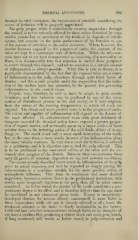Page 879 - My FlipBook
P. 879
THERMAL INFLUENCES. 889
through its vital extensions, the importance of carefully considering the
causes of irritation will be properly appreciated.
The pulp proper, while it undoubtedly receives impressions through
the enamel, is never seriously affected by these unless disturbed by some
sudden concussion or movement of the tooth or by deposits of calcific
matter, but remains in the quiet performance of its function as one
of the sources of nutrition to the entire structure. When, however, the
dentine becomes exposed by the progress of caries, the contents of the
tubes are kept in a continuous state of irritation. While the tube-con-
tents have not as yet been demonstrated as consisting of a nerve-fibre or
fibres, it is demonstrably true that sensation is carried from periphery
to centre through this channel ; and where sensation is, a certain amount
of inflammation is always possible. While this is true in theory, it is
practically demonstrated by the fact that the exposed tubes are a source
of inflammation in the pulp, oftentimes through quite thick layers of
dentine ; and this is only possible under the supposition that the irrita-
tion of the surface layer has extended, by the general law governing
inflammations, to the central tissue.
Pulpitis may, therefore, be said to have its origin in quite remote
irritation ; and this irritation may be produced by any of the many
sources of disturbance present in the oral cavity, or it may originate
from the action of the varying temperatures to which all teeth are
exposed. The direct and most positive cause is in the progress of caries.
The extent and rapidity of inflammation will de]:)end on the density of
the tooth affected. In soft-structured teeth with great deficiency of
inorganic material the chemical action leaves exposed a greater propor-
tion of organic matter, and necessarily opens up a larger surface of inner
tubular tissue to the irritating action of the acid fluids, debris of decay,
fungi, etc. The result is not only a more rapid destruction of the tooth,
but, at the same time, a more speedy increase of the inflammation along
the inner tubular contents. In very dense teeth the irritation is reduced
to a minimum, and it is therefore rare to And the pulp affected. This
is to be attributed to the contracted calibre of the tubes and the ex-
tremely slow progress of the disease. Between these two extremes there
exist all grades of structure dependent on age and systemic conditions.
The causes already described rarely result in inflammation of the pulp
prior to actual exposure, and may be regarded as simply placing the
tube-contents in a condition suitable for the more positive action of
atmospheric influence. This, from its continuous and more decided
impression, becomes a serious factor in the preliminary irritations, with
results more frequently injurious to the pulp than all the other causes
combined. As before stated, the density of the tooth contributes a pro-
portionate degree to its eftect, and it therefore follows that the age must
be considered in any treatment given teeth. Young or imperfectly-
developed dentine, for reasons already enumerated, is more liable to
these impressions, while old age is scarcely affected at all ; hence the
treatment adapted to the latter is clearly inadmissible in the former.
Cold and heat, whether communicated through fluids or by draughts of
air, have a similar effect, producing a violent shock and acute pain, which,
if long continued, will result, as before stated, in pulp-irritation and


